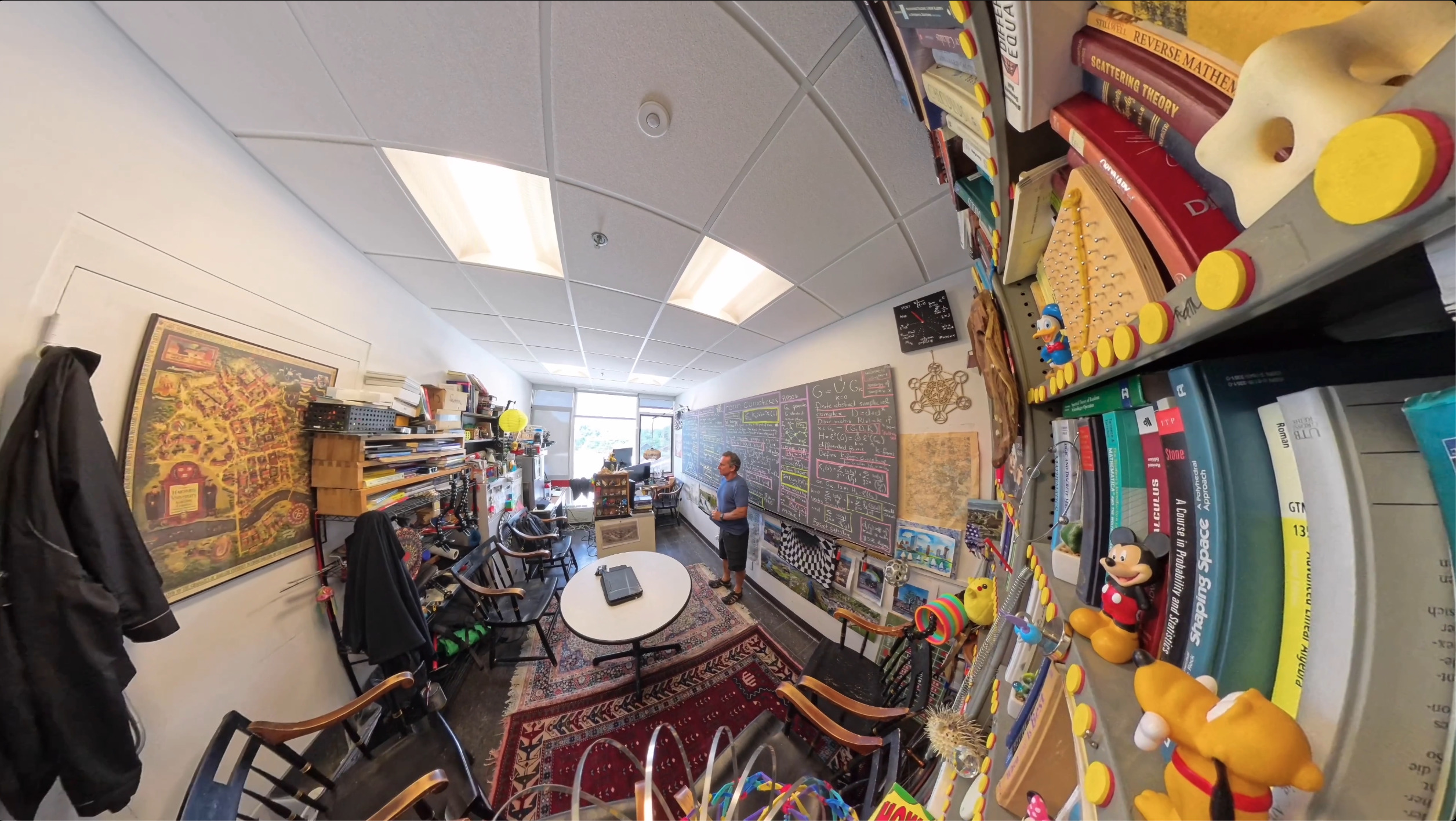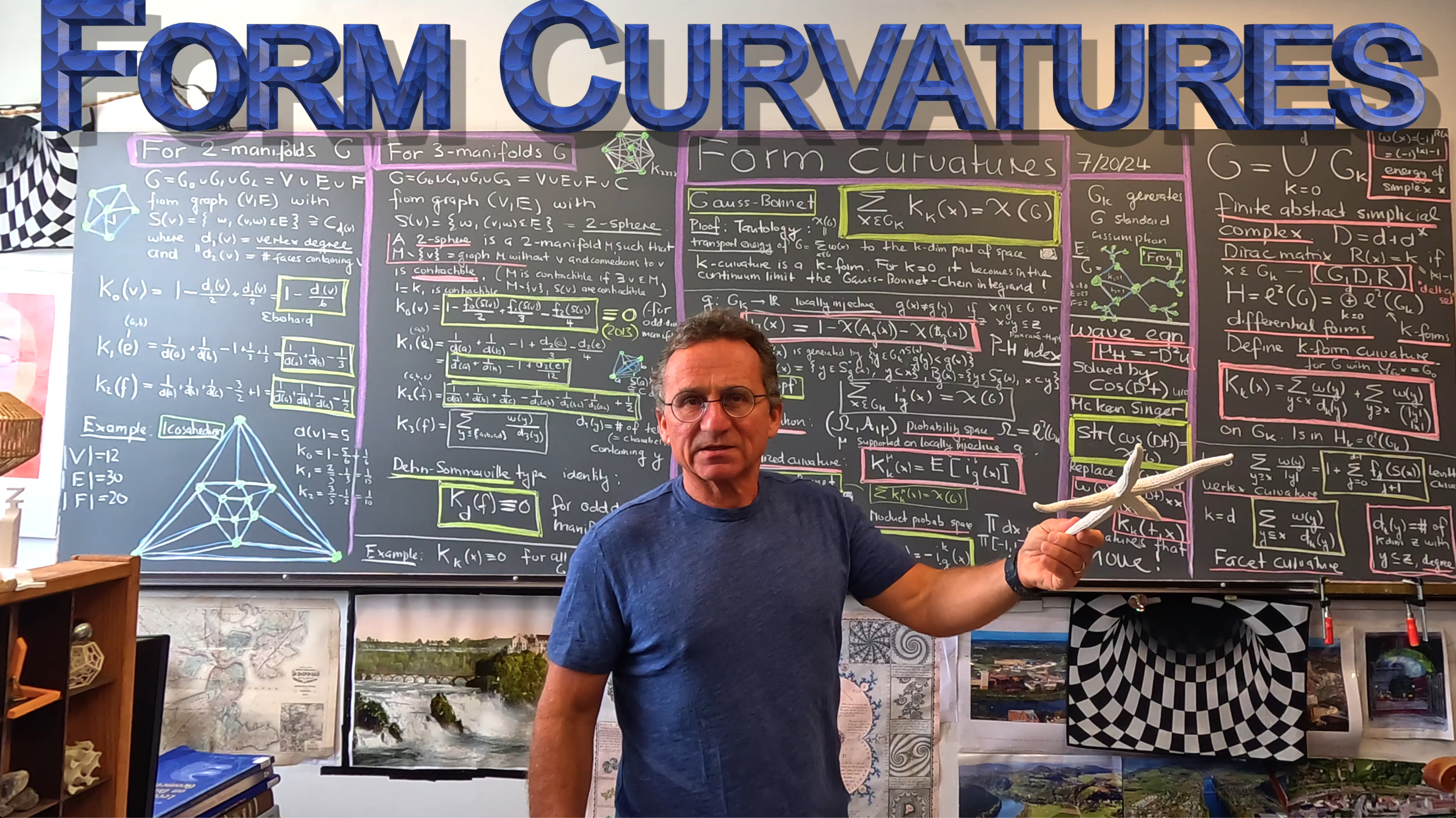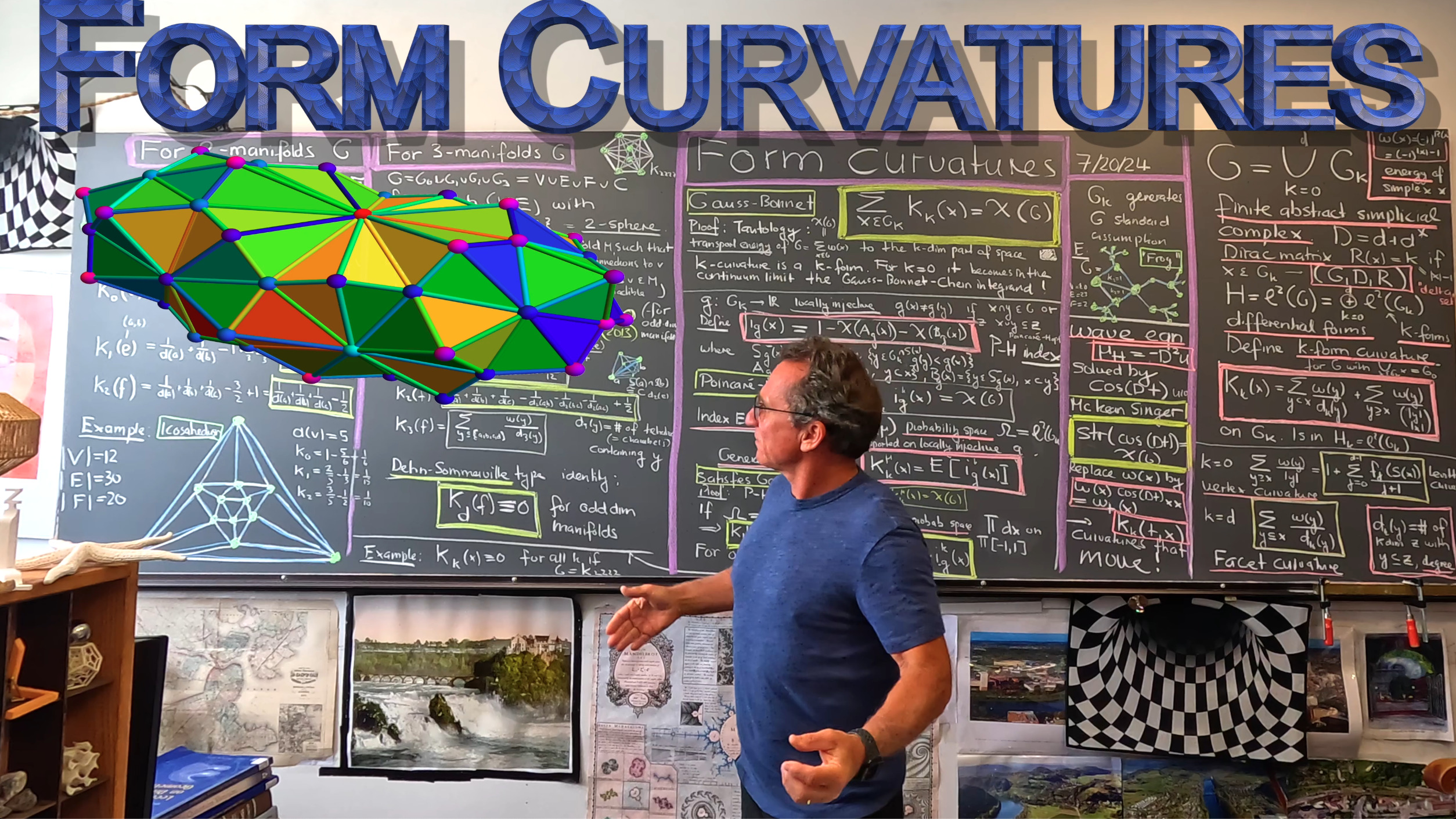An abstract delta set (G,D,R) is a finite set G with n elements, a selfadjoint Dirac matrix
with
and a dimension vector
defining a partition
and Hilbert spaces
called the spaces of k-forms. The exterior derivative
maps
to
. The Hodge Laplacian
is a block diagonal matrix defining the Hodge blocks
and
are the Betti numbers quantifying how large the k’th cohomology
is. The kernel of
is the vector space k-harmonic forms. The Euler characteristic
of G is the total energy of space, where
is the energy of a simplex
. If
is the cardinality of
, then
is called the Euler-Poincare formula. It follows directly from the McKean-Singer symmetry stating that the non-zero eigenvalues of
on
agree with the non-zero eigenvalues of
on
implying
for positive k so that the super trace of the heat operator
is time
independent and agrees with
. The super trace of an operator A on
is defined as
complementing the trace
. The Euler-Poincare formula just restates that the super trace of the heat operator at
is the same than the super trace of the heat operator at
as the limiting operator
is the projection onto harmonic forms, the kernel of L which is
. The McKean-Singer symmetry more generally implies that the super trace of
is independent of
for any entire function
satisfying
. An example is the heat operator
which has the property that
satisfies the heat equation
. An other example is the wave operator
or its real part
, which has the property that
solves the wave equation
. If we look at
as a curvature because it adds up to Euler characteristic, we can also look at
as a time dependent curvature. We can still look at the entries
as energies attached to the simplex
. These deformed curvature forms still satisfy Gauss-Bonnet and more.
Call an element g in locally injective if
whenever
or
is contained in some
. Such a locally injective k-form defines a total order on the unit ball
of any simplex
. The simplex
therefore can send its energy to the
on which
is maximal. If all simplices have moved their shipping, we end up with the energy concentrated on
. Since all packages have been integers, the value
on each
is an integer meaning it is a divisior. No energy was lost so that we have the Poincare-Hopf theorem
. Given a probability measure
on the set
of locally injective functions, we get the index expectation curvature as expectation
. By Fubini, we have the Gauss-Bonnet formula
. In the case when
is the product probability space
(take IID random variables on
with values in
and assuming the uniform Lebesgue probability measure
on
, we end up with the k-form curvature. It can be seen as the situation, where the energy
on the simplex
is distributed equally to each of the k-simplices
which either contain x or are contained in x. An explicit formula for that is
, where
means strict inclusion and the degree
is the number of
with $latx y \subset z$. In the case of d-manifolds G, spaces where each unit sphere is a (d-1)-sphere (defined recursively), we can simplify formulas. In that case, the 0-curvatures as well as the d-curvatures are all constant zero provided the measure
is symmetric with respect to the involution
. These are Dehn-Sommerville manifestations for k=0. To summarize what we just did is in a rather general combinatorial frame work to show that the analytic index
is the topological index
. To the analytic index, one uses that D also defines a map from
to
. Seen as such, we have a Atiyah-Singer statement. (I wrote once something about discrete Aityah-Singer in 2017).
What we did in a few lines gives precise definitions and results in a combinatorial linear algebra frame work which takes a considerable amount of time to establish in the continuum where we are blind about the k-dimensional part of space. We need quite a bit of functional analysis and algebra and topology and differential geometry in order just to make sense of the expressions that are involved. We need for example to understand the spectral property of the self-adjoint Laplacian. A common frame work in the continuum is that is a smooth Riemannian d-manifold. A very special case of Atiyah-Singer is the Gauss-Bonnet-Chern theorem for even dimensional compact Riemannian manifolds. It takes a considerable amount of effort to set up the mathematics: we need tensor calculus just to define notions like the Riemann curvature tensor, we need elliptic regularity to establish that the spectral behavior of the Laplacian is nice. In order to define a square root of the Laplacian we can still use the algebra of differential forms which as a vector space hosts the Clifford algebra structure, the frame work used to define for example the Dirac matrices. Note that in the discrete setup we do not require at all that the d is the traditional exterior derivative. We can use it for higher characteristics like quadratic characteristic in which
are pairs of intersecting simplices in a simplicial complex for which the dimensions add up to k. The total energy is then Wu characteristic , which is the Ising type energy
. Everything is the same. We have then k-form curvatures adding up to Wu characteristic. We can also deform the Dirac matrix using the isospectral flow
which does not affect the Laplacian
but defines new exterior derivatives (as well as some “dark energy”
as
develops a diagonal part
. The new
can be used to define distance via the Connes distance formula
(which only needs the Dirac operator and obviously works in the discrete and also with deformed Dirac matrices. If the
shrink then space expands. One can also see this from the solution
where u'(0) is in the ortho-complement of the kernel of D. If D gets smaller, the propagation speed appears to get smaller, which can be read as if space expands). Also the nonlinear wave operator
defining
can be used to define a curvature motion. Just take
. It works because the super trace of the nonlinear wave operator is still constant by McKean Singer. Apropos Connes: the delta set (G,D,R) of course immediately also gives a spectral triple (A,H,D), where
is the algebra of functions on
and
, which is summable because we are in finite dimensions. Interestingly, the free evolution of the Dirac matrix in its isospectral class always produces an expansion of space with an inflationary start. This is not a “Deus ex machina frame work” but a mathematical result which holds for any positive dimensional finite geometry (as well as in the continuum when deforming the Dirac operator
on a Riemannian manifold.) There is some Mathematica code illustrating this on this Wolfram community blog. (And Here (.nb file) is the mathematica notebook to this community blog entry. )
In order to see the relation between the discrete and the continuum, the integral geometric formalism helps. Take an even dimensional compact Riemannian d-manifold M. By Nash’s embedding theorem, we can assume that M is isometrically embedded in a larger dimensional Euclidean space E. There is a natural probability space of Morse function on E: take the set of linear functions with n in the standard sphere
in E. There is a natural probability measure on S coming from the rotationally symmetric Haar measure on the compact Lie group of all rotations SO(E) of E. Now, almost all such linear functions induce Morse functions on the manifold M. The traditional continuum Poincare-Hopf theorem on M tells that
, where
is the divisor on M giving non-zero integer index at finitely many points. In the Morse case, the support of
are the critical points of the Morse function
and the index takes values in
at critical points, depending on whether the Morse index (the number of negative eigenvalues of the Hessian
) is odd or even. The index expectation
must now be the Gauss-Bonnet-Chern integrand. It is a curvature that is locally invariant under rotations of the frame bundle defined near a point. It was Hermann Weyl who once showed that there is only one curvature which satisfies this property. The Gauss-Bonnet-Chern integrand had already been known by Heinz Hopf. The theorem slowly developed from smooth convex hypersurfaces in E to hypersurfaces in general, then larger codimension until Chern freed it from embeddings in an ambient space. The Nash-Embedding theorem also establishes the result. But how do we relate the discrete from the continuum? We do not have a metric given on G yet but if we take G to be a fine triangulation of the manifold M, then each point and simplex in G has spacial coordinates attached in the ambient Euclidean space E we have placed M into. This means that G is geometrically realized as a d-dimensional polyhedron in E or what one sometimes calls a concrete simplicial complex (in comparison an abstract simplicial complex is freed from any Euclidean parts). The probability measure of Morse functions now produces discrete curvatures on G. These curvatures (at least when averaged over some region) converge now to the Gauss-Bonnet-Chern curvature. A possibility to do this is to assume that the vertices of G are an
dense set in the compact manifold M. We can now average the curvature
and get close to
which converges to
for
.


























